Navigation
Install the app
How to install the app on iOS
Follow along with the video below to see how to install our site as a web app on your home screen.
Note: This feature may not be available in some browsers.
More options
You are using an out of date browser. It may not display this or other websites correctly.
You should upgrade or use an alternative browser.
You should upgrade or use an alternative browser.
Misting system...in the works
- Thread starter summoner12
- Start date
ChamNovice
New Member
Why the LED's? Surely a little blue dot would have sufficed to indicate that it was the cold valve!?
Gotta re-use my quote from before on this oneIf it ain't broke... there's gotta be a way to complicate it....
Why have just a blue dot when you can have LED'S??? Flashy lights are way cooler than colored dots.
Everything except for the logic programming really isn't to difficult(to me). It is very similar to adding all kinds of fun electronics/air ride/hydraulics on your vehicle, I love low volt electrical systems. The logic programming may be easier than I think, I have never done any of that though. What are you using for your controls?? What is the hardware used to convert the logic into the actual electrical signals.
I get the concept of this type of programming
If X > certain number, let Y do something
If X < certain number, let Z do something
Just not sure how yours operates and what you are using to write logic, and programming it into. I should probably just try to have an in depth conversation with you via PM sometime.
summoner12
Avid Member
Why the LED's? Surely a little blue dot would have sufficed to indicate that it was the cold valve!?
Well I was just going to use the green LEDs I had already... but I was like 'screw that! what if I forget which is which if they are both green?
The LED is only on when the valve is on..... and a dot won't be able to decipher such complicated things...
summoner12
Avid Member
this system is amazing. are you running it on all yr animals?
Yes, currently all of the animals are getting RO. I was able to get things running by using my old control system. I am still working on the main controls. Still getting the pieces together and building things.
Today my electronics enclosure came in. Smoken deal on eBay! I also got in the temp sensors I have been waiting on.
Tonight I played with the new sensors and tried to play with the logic.... It wigged out on me because I wrote some code it didn't like, I think.... either way I got it to work for me again and am realizing I need to be a bit more focused when I am trying to teach myself the logic of this program. It is a bit annoying since I don't know computer programming.
reyesjoshuacruz
Established Member
i was thinking about putting together insteon kits for forum members and programming them up before shipping them out. and supporting them after. We can take any input and convert that into any output, ir, temp, contacts, 110v sense, plc, motion, photo cell, sunset/sunrise complex if, then, else conditions, remote network connections ect..
i just dont know what everyones price point would be. anyone got a good design for auto feeders? im working on something that will allow you to use a comp/ phone to view your cham, turn on or off lights, dim them ( adjust temp ) and release crix. how cool would that be, i got everything down except the crix
i just dont know what everyones price point would be. anyone got a good design for auto feeders? im working on something that will allow you to use a comp/ phone to view your cham, turn on or off lights, dim them ( adjust temp ) and release crix. how cool would that be, i got everything down except the crix
summoner12
Avid Member
i was thinking about putting together insteon kits for forum members and programming them up before shipping them out. and supporting them after. We can take any input and convert that into any output, ir, temp, contacts, 110v sense, plc, motion, photo cell, sunset/sunrise complex if, then, else conditions, remote network connections ect..
i just dont know what everyones price point would be. anyone got a good design for auto feeders? im working on something that will allow you to use a comp/ phone to view your cham, turn on or off lights, dim them ( adjust temp ) and release crix. how cool would that be, i got everything down except the crix
Does insteon do anything with analog inputs? The price for a lot of these things adds up to what I've spent and most of what I have I would need to buy anyway. My biggest issue is getting a controller that does temperature. The control cards I have are very simple and cheap... I just don't know how to program code.... so I am learning, but ya can't beat the price for what it can do. I need a sober night where I can tinker with it
I have thought about just buying a mini PLC and integrating it into what I am using because the cost increase really wouldn't be very much. The only reason I would do this is for ease of programming. Having a computer with HMI to do the program and stuff would be much easier than code
Either way I don't regret the controller I have... just wish I knew computer logic/logic better
summoner12
Avid Member
Yippee!
SOOO I got a section of the RO system working, I have been working on it most of the afternoon

When you run your RO its a good idea to flush the membrane at the end of a cycle. When you do this you want to bypass the flow restrictor. This is so water just moves along the membrane, not putting pressure on it.
In order to do this I put a bypass valve that, when open, flows water past the restrictor.
This is the pre-assembly of it, with blue hose. The little white piece is the restrictor.

Here is the assembly installed with black tubing.

So This afternoon I spent some time messing around with my logic controller. I wanted to figure out how to make the bypass valve work in the system. Right now the RO works stand along with itself. There is a pressure switch on the tank. when the tank is full it closes the feed water valve and turns off the booster pump. when the tank drops in pressure it opens the feed valve and turns on the booster...... back and forth based on pressure. In order to get the bypass valve to work I need some logic... a computer to think. The logic computer will look at the position of the pressure switch and determine what needs to happen.
When the computer sees the pressure switch click to the 'closed' position (on) it will turn on the pump and feed valve. This will 'turn on' the RO process and start making water to fill the tank. Once the tank is full it will click the switch to the open position (off). The computer will see this and this is where the logic comes in..... It will tell the pump and feed valve to turn off and at the same time turn on AND off, the bypass valve... BUT there is a 'off' delay time. At the same time that all happens the computer starts a count down. When the count is complete all the components turn off, completing the RO cycle.
Here is a video I made using a toggle switch to simulate the tank pressure switch. I made the times short so you can see how it works.

First I click on the switch and wait. The two LEDs that turn on represent the booster pump and feed valve. Then I click the switch off and the third LED comes on, representing the bypass valve, and the countdown begins. at the end of the count the LEDs click off, representing the system is off.
happy happy joy joy!
SOOO I got a section of the RO system working, I have been working on it most of the afternoon
When you run your RO its a good idea to flush the membrane at the end of a cycle. When you do this you want to bypass the flow restrictor. This is so water just moves along the membrane, not putting pressure on it.
In order to do this I put a bypass valve that, when open, flows water past the restrictor.
This is the pre-assembly of it, with blue hose. The little white piece is the restrictor.
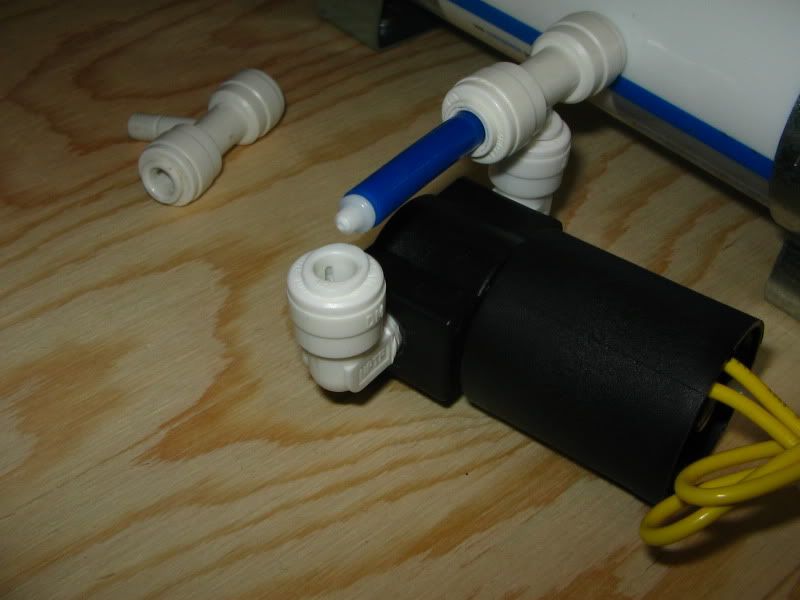
Here is the assembly installed with black tubing.
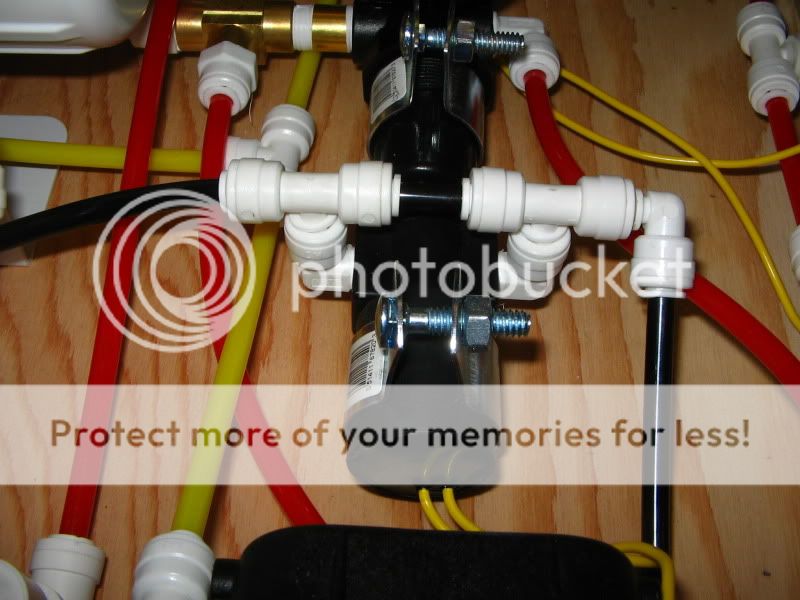
So This afternoon I spent some time messing around with my logic controller. I wanted to figure out how to make the bypass valve work in the system. Right now the RO works stand along with itself. There is a pressure switch on the tank. when the tank is full it closes the feed water valve and turns off the booster pump. when the tank drops in pressure it opens the feed valve and turns on the booster...... back and forth based on pressure. In order to get the bypass valve to work I need some logic... a computer to think. The logic computer will look at the position of the pressure switch and determine what needs to happen.
When the computer sees the pressure switch click to the 'closed' position (on) it will turn on the pump and feed valve. This will 'turn on' the RO process and start making water to fill the tank. Once the tank is full it will click the switch to the open position (off). The computer will see this and this is where the logic comes in..... It will tell the pump and feed valve to turn off and at the same time turn on AND off, the bypass valve... BUT there is a 'off' delay time. At the same time that all happens the computer starts a count down. When the count is complete all the components turn off, completing the RO cycle.
Here is a video I made using a toggle switch to simulate the tank pressure switch. I made the times short so you can see how it works.

First I click on the switch and wait. The two LEDs that turn on represent the booster pump and feed valve. Then I click the switch off and the third LED comes on, representing the bypass valve, and the countdown begins. at the end of the count the LEDs click off, representing the system is off.
happy happy joy joy!
summoner12
Avid Member
A little update. I am scrapping the water temp logic idea for now. Hot water does have a REALLY high TDS. I was getting like 1000-1100 DTS using hot water mixed with some cool water to get the right temp... now I am just using the 'cold' water feed and will hook it back up to my DIY water heater lol
Vegas Chad
Avid Member
At one point somewhere you were talking about the pressure in the home lines being more than what is needed to mist, thus bypassing the pump. Well I found that my house has high pressure, what reducer did you use to dial it down a bit?
GooglezNvincent
New Member
So how many hours and how much money have you put into this thing, and when will it be finished? I cant wait for a video of your system up and running!
philanddeb818
Established Member
^
Geeeeze Kev, I burned up so many brain cells just reading through your inventions! Thank you for putting them up for all of us to see.
We've been looking at RO for a while and Buckeye is really a good route for us. Thanks for laying it all out so thoughtfully in your posts! You're waaayy smart.
Cheers,
D.
Geeeeze Kev, I burned up so many brain cells just reading through your inventions! Thank you for putting them up for all of us to see.
We've been looking at RO for a while and Buckeye is really a good route for us. Thanks for laying it all out so thoughtfully in your posts! You're waaayy smart.
Cheers,
D.
summoner12
Avid Member
At one point somewhere you were talking about the pressure in the home lines being more than what is needed to mist, thus bypassing the pump. Well I found that my house has high pressure, what reducer did you use to dial it down a bit?
If you plan to just tap your water supply and hook up a bunch of valves that go to different misting 'zones' and you want to cut the pressure down... You can go to HD and pick up a regulator. But you need to look at the range of adjustment. some are just set to keep the pressure at one setting and some don't adjust all that low... most adjustable regulators should be fine since you don't need to tune it much lower than 30PSI. I got my regulator from the same people I purchased my RO system from, Buckeye Field Supply. That regulator is pretty compact. works well for me. I have it after my Mist King pump and it keep my misting pressure at 90PSI.
And thanks for the comments Phil and Deb. It was nice seeing you at the meeting last weekend.
Vincent, I have no idea how much time or money I have spent... as for when it will be finished? prolly never because I will want to change it in some way... It is running right now... As far as it being finished in the sense of operating... its finished. but as to the controls and expansion, prolly never be finished lol.
summoner12
Avid Member
or buy something just as good for $60
save space and time
Buy what for $60?
summoner12
Avid Member
Been messing with the system... obviously it's a mess.... but I got the zip drip installed didn't htink I needed it.. but i've been having an issue with the pump being under pressure for a while and it was bothering me. It isn't making issues for the system... but i think it could, so i took care of that problem.



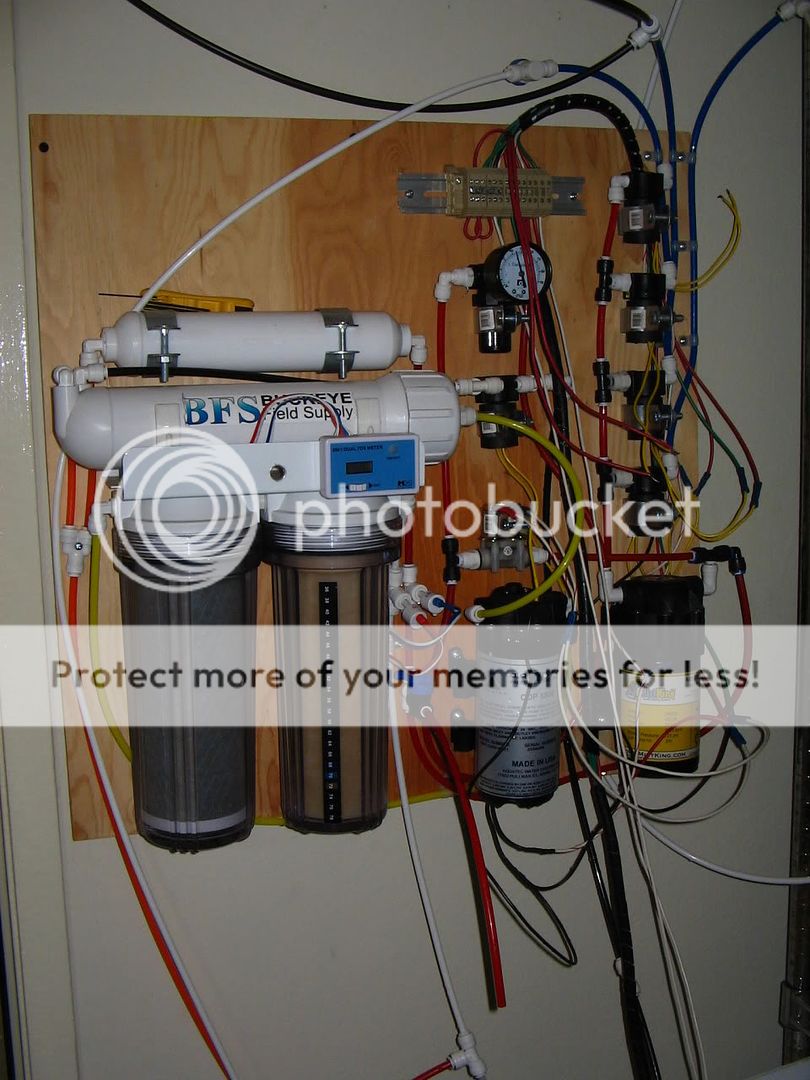
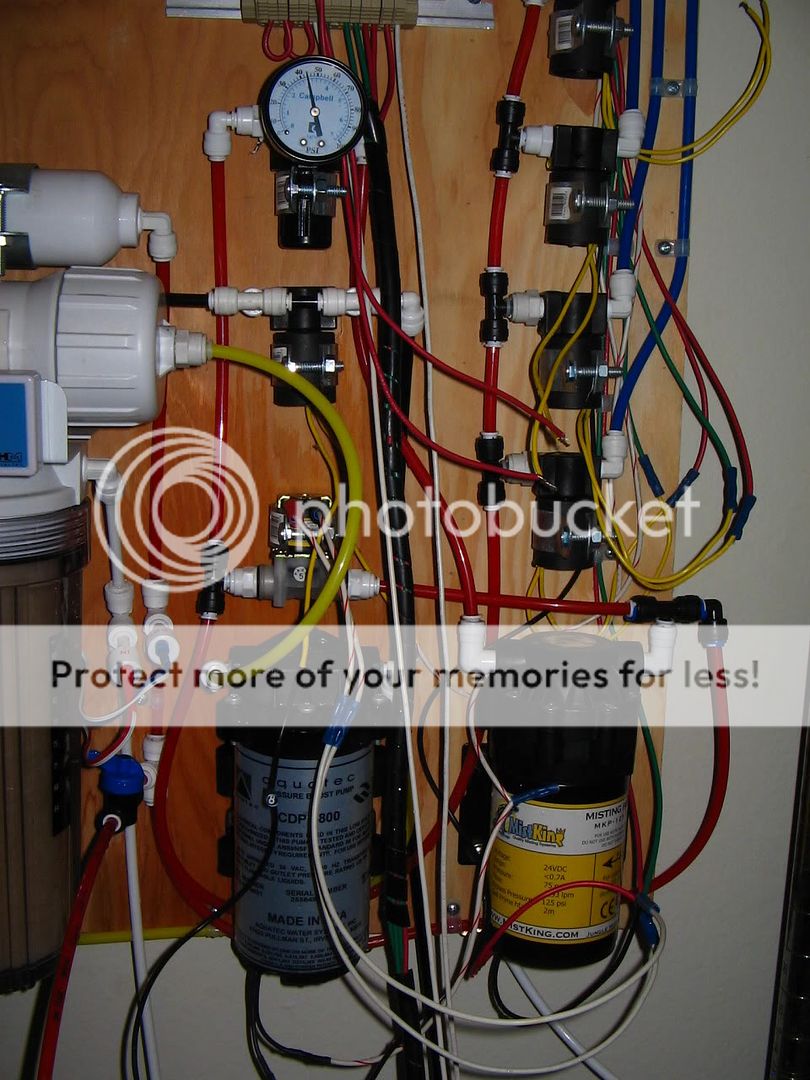
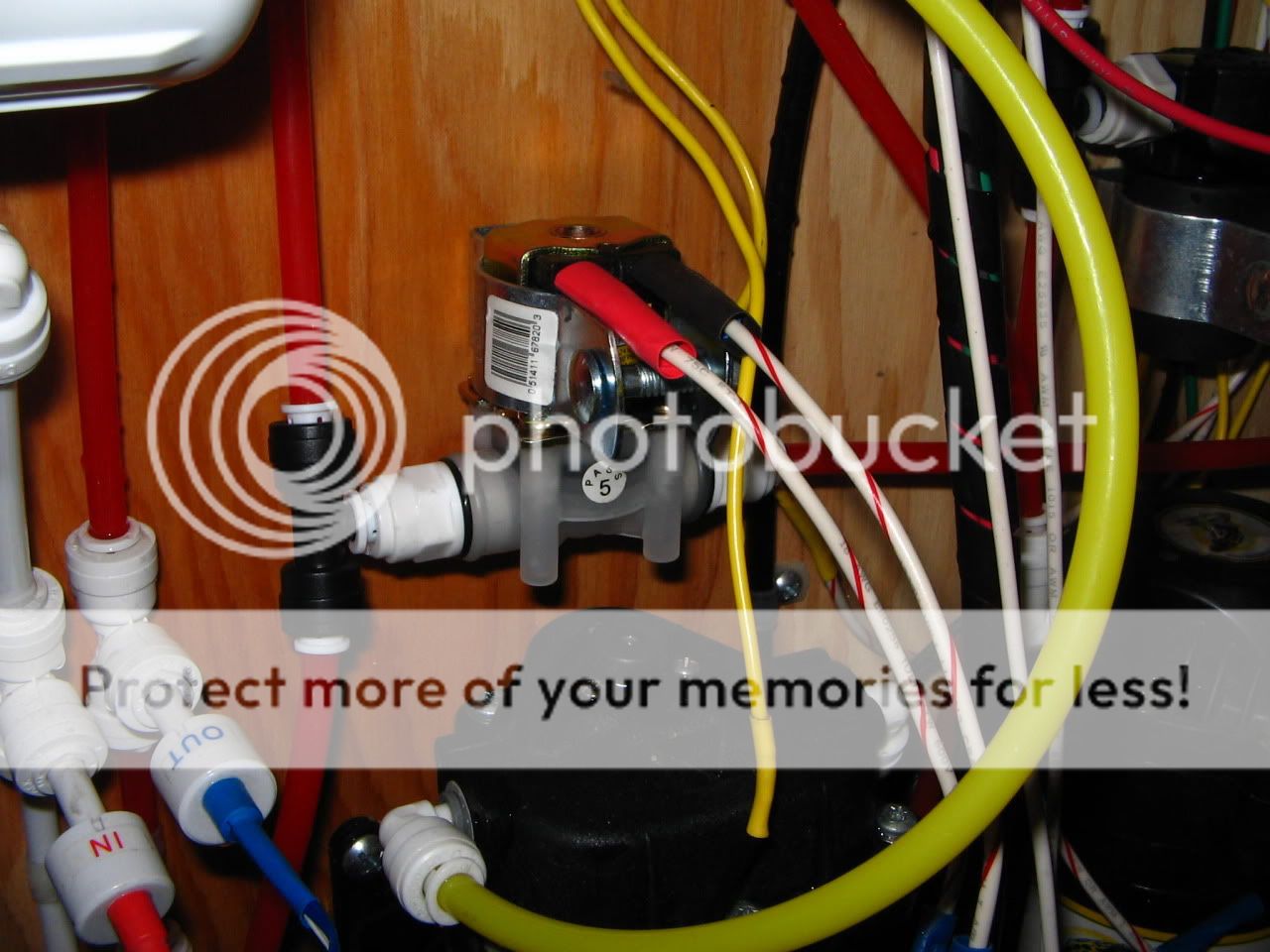
summoner12
Avid Member
Yes you obviously did!
lol
The reason I needed to install the Zip-Drip isn't because i have drips. Most people who will buy a Mist King will not set it up like I have mine. I have a supply of water to the pump and then the water is pressurized by the pump and then goes to a regulator and then goes to valves. Most people don't have the valve or regulator.
So the purpose of the Zip-Drip in the 'normal' setup is to let water pressure between the nozzles and the pump, be released. If this doesn't happen the pressure causes the nozzles to drip as the pressure slowly seeps out of the nozzles. So basically it is a relief valve.
Now in my system I don't need this because when my valve closes at the end of a misting cycle, the presure stops. BUT the pump runs for a half second or more causing pressure to build behind the valve. This pressure slowly bleeds back through the pump but I fear it could cause issues down the road. So I installed the Zip-Drip. There is still that build up of pressure after the misting valves turns off, but after about 3-5 seconds the Zip-Drip valve opens letting the pressure between the misting valves/pump to equalize with the water supply.
See, easy
Similar threads
- Replies
- 1
- Views
- 1K
- Replies
- 4
- Views
- 1K



